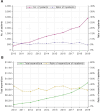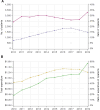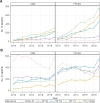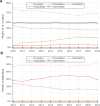Trends of Korean medicine service utilization for lumbar disc herniation and spinal stenosis: A 10-year analysis of the 2010 to 2019 data
- PMID: 39058889
- PMCID: PMC11272331
- DOI: 10.1097/MD.0000000000038989
Trends of Korean medicine service utilization for lumbar disc herniation and spinal stenosis: A 10-year analysis of the 2010 to 2019 data
Abstract
This retrospective, cross-sectional, and descriptive study aimed to analyze the trend of utilizing traditional Korean medicine services in patients with lumbar disc herniation (LDH) and/or lumbar spinal stenosis (LSS). In this study, based on the national patient sample data provided by Health Insurance Review and Assessment Service (HIRA), the trend of Korean medicine service utilization was investigated, including the following information: demographic characteristics of the patients, the total expenditure, number of claim statements per category, medical care expenditure per category, and routes of visiting traditional Korean medicine institutions. The study population comprised patients who visited Korean medicine institutions at least once from January 2010 to December 2019, with LSS and LDH as the primary diagnosis. LDH patients who used traditional Korean medicine services for treatment increased by about 1.36 times. LDH and LSS patients under 45 years of age were more likely to be males, but women accounted for a higher percentage among those over 45 years of age. Overall, women accounted for a slightly higher percentage than their counterparts for both diseases. From details of treatments received that were extracted from the claims data, acupuncture treatment accounted for the highest percentage for both disorders. Moreover, 50.7% of the patients who visited Korean medicine institutions to treat the two diseases also visited conventional Western medicine institutions. These patients, who were diagnosed with their condition at a Korean medicine institution, visited a conventional institution and then returned; the conventional institutions were primarily used for examination (40.5%). Increased utilization of traditional Korean medicine services was confirmed among patients with LDH and/or LSS; in particular, a sharp increase was noted among patients with LSS. The results of this study will be useful as basic research data for clinicians, researchers, and policy makers.
Copyright © 2024 the Author(s). Published by Wolters Kluwer Health, Inc.
Conflict of interest statement
The authors have no conflicts of interest to disclose.
Figures





Similar articles
-
Trends of Surgical Service Utilization for Lumbar Spinal Stenosis in South Korea: A 10-Year (2010-2019) Cross-Sectional Analysis of the Health Insurance Review and Assessment Service-National Patient Sample Data.Medicina (Kaunas). 2023 Aug 31;59(9):1582. doi: 10.3390/medicina59091582. Medicina (Kaunas). 2023. PMID: 37763701 Free PMC article.
-
Evaluation of use and cost of medical care of common lumbar disorders in Korea: cross-sectional study of Korean Health Insurance Review and Assessment Service National Patient Sample data.BMJ Open. 2016 Sep 12;6(9):e012432. doi: 10.1136/bmjopen-2016-012432. BMJ Open. 2016. PMID: 27619830 Free PMC article.
-
Hysterectomy-a possible risk factor for operative intervention in female patients for degenerative lumbar spine conditions: a case control and cohort study.Spine J. 2024 Nov;24(11):2066-2077. doi: 10.1016/j.spinee.2024.06.019. Epub 2024 Jun 24. Spine J. 2024. PMID: 38925298
-
[Visualization analysis of CiteSpace knowledge map for lumbar disc herniation treated with acupuncture and moxibustion].Zhongguo Zhen Jiu. 2017 May 12;37(5):545-548. doi: 10.13703/j.0255-2930.2017.05.024. Zhongguo Zhen Jiu. 2017. PMID: 29231618 Review. Chinese.
-
Lumbar Disc Herniation with Contralateral Symptoms: A Case-Series of 11 Patients and Literature Review.Orthop Surg. 2023 Nov;15(11):2839-2847. doi: 10.1111/os.13849. Epub 2023 Sep 25. Orthop Surg. 2023. PMID: 37749774 Free PMC article. Review.
Cited by
-
National Health Insurance Data as a Research Tool in Korean Medicine: a guide to database utilization and methodological approaches.J Pharmacopuncture. 2025 Mar 31;28(1):1-10. doi: 10.3831/KPI.2025.28.1.1. J Pharmacopuncture. 2025. PMID: 40165879 Free PMC article. Review.
References
-
- Deyo RA, Weinstein JN. Low back pain. N Engl J Med. 2001;344:363–70. - PubMed
-
- Lee JH, Moon J, Lee SH. Comparison of effectiveness according to different approaches of epidural steroid injection in lumbosacral herniated disk and spinal stenosis. J Back Musculoskelet Rehabil. 2009;22:83–9. - PubMed
-
- Jensen MC, Brant-Zawadzki MN, Obuchowski N, et al. . Magnetic resonance imaging of the lumbar spine in people without back pain. N Engl J Med. 1994;331:69–73. - PubMed
-
- Watters WC, 3rd, Baisden J, Gilbert TJ, et al. . Degenerative lumbar spinal stenosis: an evidence-based clinical guideline for the diagnosis and treatment of degenerative lumbar spinal stenosis. Spine J. 2008;8:305–10. - PubMed
MeSH terms
LinkOut - more resources
Full Text Sources
Medical

